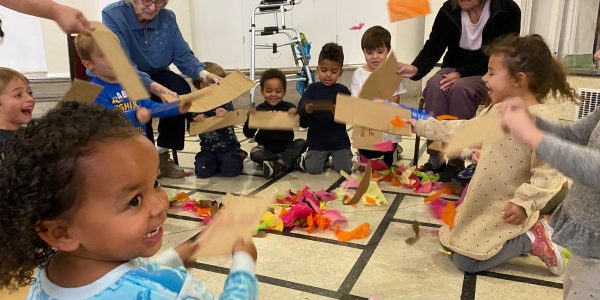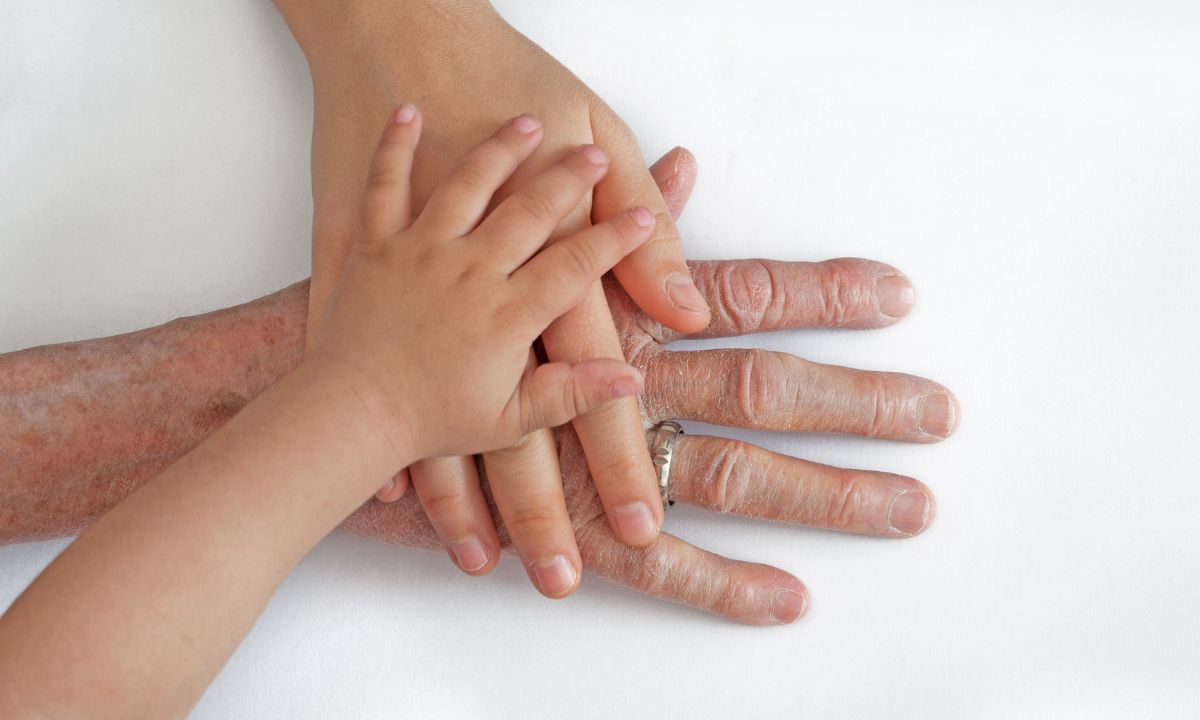Jaime Moran brings her mother, Joan Johnson, to work each day at Kindness Creators, the child care program she co-directs with Pam Lawrence. Having run a home-based child care, Johnson is an inspiration to her daughter, and now, as a senior with dementia, she benefits from spending time at Oak Park Arms, the Chicago suburban senior living community that houses the child care center.
Kindness Creators is an Intergenerational Day Center (IDC), a model for simultaneously supporting adults in need of long-term care and addressing the needs of families with young children. Combating an epidemic of social isolation, the program also brings communities together in ways that have faded in recent decades.

Moran and Lawrence, both early childhood educators, have direct experience with older Americans and the issues they face. Moran has lived virtually her whole life around people with dementia, starting with her grandfather and continuing with her mother. Lawrence’s mother resided in a nursing home at the end of her life and had debilitating mental illnesses.
The 2017 documentary “The Growing Season” (originally known as “Present Perfect”), which spotlights a Seattle retirement home with its own child care center, inspired Moran and Lawrence to approach Oak Park Arms, which is located in the economically and ethnically diverse suburb where they live. When they proposed their idea to executive director Moses Williams, they thought they’d have to try harder to persuade him, but he immediately gave the idea a green light – which meant they had to act quickly. Kindness Creators opened its doors in 2019, originally providing care for 12 children. Today, the program serves 20 children ages 3 to 5 years old across four classrooms.
A New Wave in Care
The care sector is stretched thin for older as well as younger Americans. Amid chronic staffing shortages in child care and elder care, IDCs represent what a 2023 study called “a new wave” in care for adults and young children. The study’s authors assert that “IDCs foster learning opportunities for both generations and increase social engagement among older adults and children who need not be family. Intergenerational programs produce advancement in sensory stimulation; enhancement of self-esteem; increased positive socialization, and intellectual development for both older adults and children.”
According to Generations United’s Intergenerational Program Database, there are 15 such programs around the country, and interest has grown since the pandemic, says Donna Butts, the advocacy group’s executive director. “We’re all more aware of loneliness and social isolation now,” she reveals. “It’s not healthy for older adults to be shut inside their own little senior-only world.” She also cites research supporting the learning benefits for children and adds that senior centers are increasingly building child care centers because they see it as a workforce retention opportunity; staff feel more connected when the facility offers child care as a benefit.
Each day, the children and the seniors have most of their programming in separate parts of Oak Park Arms. They come together for miniature golf on Mondays, calm coloring on Thursdays and holiday-related activities such as cupcake decorating for Veterans Day. During a farm-themed art workshop in the ballroom, Marge Schwartz, one of the Oak Park Arms residents, who the children affectionately call “Ms. Marge,” shared that she takes part in every intergenerational opportunity she can.
“I don’t have any children or grandchildren to visit me here,” she says, “so this cheers me up.”
Moran says the residents often express gratitude. She recalls one of them, a Chicago firefighter, once telling her, “You saved my life.” Sometimes, though, she learns about the impact her program has on a resident only after they die.
Death, of course, is a fact of life, but many early educators avoid the topic. Moran says the teachers at Kindness Creators don’t shy away from conversations about death. They draw upon developmentally appropriate resources such as the children’s book Why Do Things Die? by Katie Daynes.
A Culture of Caring
Moran highlights ways that interacting with the seniors enriches the children’s education. “When Ms. Shirley had pneumonia,” she recalls, “We learned about the lungs and what they do. When a friend dies, we talk about it. We tell the truth and share our feelings.”
In other words, it’s about developing empathy, a core element of social emotional learning, which, in turn, makes young learners more receptive to new concepts. As Nel Noddings, the influential director of the Stanford Teacher Education Program, once told Learning for Justice Magazine, “Kids do better in a culture of caring.”
Moran describes encounters between the children at Kindness Creators and the seniors at Oak Park Arms. Residents have various challenges and needs that the children may not yet have exposure to — some, for example, are missing a limb due to complications from diabetes, others have cloudy eyes from cataracts. Mixing generations inevitably produces uncomfortable moments. Some children, she notes, are nervous when they first see a wheelchair or a tennis-ball-footed walker, but discussing disabilities in advance helps them process their reactions. Moran also says some residents are overly enthusiastic with the hugging, which gives teachers an opportunity to talk about communicating boundaries.
Sometimes, she shares, unplanned delights result from intergenerational contact. Moran mentions a resident who relied on a handheld electronic device to speak after having his larynx removed. “The kids started calling him ‘Mr. Robot,’” she laughs, “and I started to ask them not to say that, but then he embraced the nickname.”
Whether silly or serious, interactions between the youngest and oldest individuals in a community represent rare opportunities to learn from each other and to develop social emotional skills that last a lifetime. “Our whole program is based on feelings,” Moran says. “This is where kids learn that looking someone in the eyes and saying, ‘Good morning’ can make their whole day.”
Support for this reporting was provided by the Better Life Lab at New America.

Mark Swartz
Mark Swartz writes about efforts to improve early care and education as well as developments in the U.S. care economy. He lives in Maryland.



